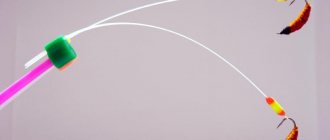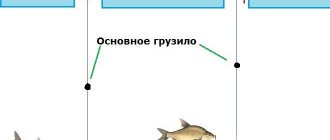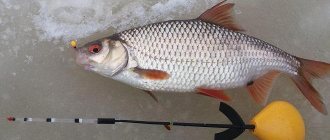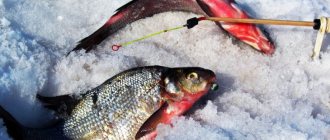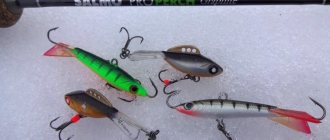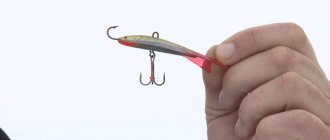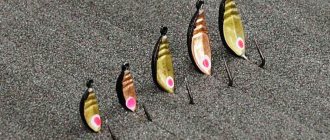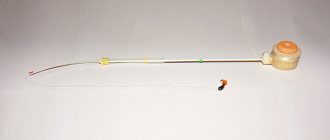Mothless without a guard
For this type of fishing, two types of fishing rods are used. The remaining forms are only derivatives of these two.
When fishing at shallow depths of up to 5 meters, a design similar to the Shcherbakov washer is used. For the convenience of fishing at greater depths and actively searching for fish in the holes, the fishing rod is equipped with a reel. There are also slight differences in the length of the whip, this is due to the nature of fishing and the personal preferences of the fisherman.
Both types of construction are lightweight. The lighter the fishing rod, the more sensitive and convenient it is to use. The blow of the bite is felt directly in the hand. You can feel any touch (like on a good spinning rod when jigging). The play of the jig and even the type of bottom are quite noticeable. This is one of the most sporty winter fishing gear.
There are many types of fishing movements: smooth rise, rhythmic rise, spring from bottom to top, pauses and fall. Not only the types of wiring are important, but also their alternation. Playing with small swings with a small amplitude without sudden jerks . With a good bite it gives unforgettable pleasure. In terms of entertainment, it is an ideal tackle.
Reelless fishing
The average length of the whip is 30–50 cm . For high-frequency play, a shorter whip is suitable; it also works well on active bass. For bream and in the dead of winter, it is better to use a longer six. It is easier for them to make soft vibrations. Devils, nymphs, and nail balls are used.
Lure fishing
The length of the whip is about 45–55 cm. If the reservoir is sufficiently stocked with fish, using large spoons, you can catch large perch in significant quantities. In this case, the rigidity of the whip should correspond to the weight of the spoon.
Fishing with a jig
This type of fishing does not provide for any design features. You need to adhere to the same technique and equipment as for the rewinder. The length of the six is an individual choice of the fisherman.
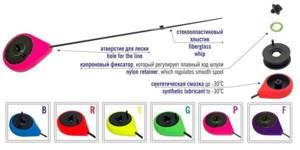
The undoubted advantage of this fishing rod is its light weight. Since the type of fishing is active, you don’t have to strain your whole arm, just moving your hand is enough. The high sensitivity of the gear allows you to instantly respond at the tactile level. The eye does not yet have time to notice, but the hand already feels the bite. Hooking occurs as if instinctively.
There is no nod, no free movement, the fish does not have time to spit out the jig before hooking. Less susceptible to wind due to the absence of soft elements in the rig. Fishing with a reelless bait without a nod is very emotional and exciting.
The downside is the large size (it won’t fit in every drawer). And since carbon, which is usually used for whips, is quite fragile, you can’t put anything on top.
Important! When using a hollow pole in cold weather, do not allow it to come into contact with water. The liquid inside freezes and stops the line from moving when reeling in.
Secrets when fishing with a reelless
Fishing with a winter fishing rod without a nod has many tricks. Knowing them and correct use of the principles of operation of the gear is the key to successful fishing:
- The fishing rod is very fragile - this must be taken into account when transporting and storing it.
- The nockless rewinder is very light. The usual practice when landing large fish from the depths - throwing the rod to the side - may not work due to the fact that the wind can bring it back.
- Rewinders are often longer than their counterparts and may not fit in a fishing box.
- Experiment often. Remember your winning jig + fishing line combination for future use.
- The rod handle should be made of a material with low thermal conductivity due to the fact that it is often held in hands without gloves.
- To increase the sensitivity of the tackle, it is better to hold the fishing rod in your hand without gloves. An alternative is to use gloves with cut off fingertips.
It’s safe to say that knuckleless fishing rods for winter fishing are some of the most sporting fishing equipment. Owning them can provide many pleasant moments to any angler.
Fishing equipment
To equip a fishing rod for this type of fishing, the stiffness of the whip is selected. The main requirement is that it should be as informative as possible. This is checked as follows: it is recommended to tie a piece of fishing line with a jig to the tip of the whip, under which the tackle is being prepared. Drops into a bucket of water and taps. If the impact is felt weakly, the stiffness changes.
As a rule, a fishing line of 0.115 is used, thinner is possible, the sensitivity will be higher. Jigs weighing from 0.25 g to 1 kg are used, depending on the type of fish and depth. They should be tied using polomar or clinch . When selecting fishing line and jig, it is very important that the bait, with its weight, pulls the fishing line in a line, without slackness or rings. Otherwise, this will lead to a deterioration in the sensitivity of the gear and, as a result, a decrease in the fishing result.
Noduleless fishing rods
The correct hookless tackle cannot be found in the store (with rare exceptions). Fishermen make such fishing rods themselves. There is nothing complicated about this - the main thing is to choose the right whip. Roughly speaking, the whip itself is the basis. It’s just that it’s also equipped with reels for storing fishing line. The correct grip is a pencil grip. The stick is clamped with fingers (two, three), and the game is played with the hand, not the forearm. To make a nockless fishing rod with your own hands, you do not need to have the skills of a mechanic. Materials, file, sandpaper, drill - everything is assembled literally on your knees. To begin with, you can try fishing with sports balalaikas or the lightest store-bought fishing rods, replacing the soft whip with a carbon one. However, over time it will become clear that it is better to lighten the fishing rod even more and switch to washers (fungi, buttons) or mini reels.
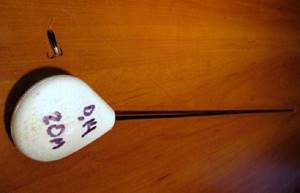
Constructions
Rod options:
- Axleless rewinder without nod.
- Sports balalaika.
- An ultra-light, no-kick, rewinder based on the Shcherbakov washer principle.
- Ultralight fishing rod with longitudinal reels.
The first two options are simple - instead of the factory one, a carbon whip is glued in, and the fishing line is clamped at the end with a cambric. However, such structures are still heavy. And if an angler is serious about fishing with a fishing rod without a nod for winter fishing, it is better to spend time and build ultra-light tackle. Let's look at how to make a nodless winter fishing rod for a reelless fish.
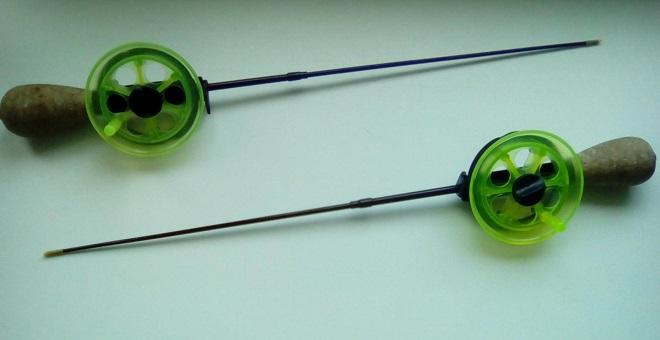
Little Rewinder

Sometimes you can find this in a store
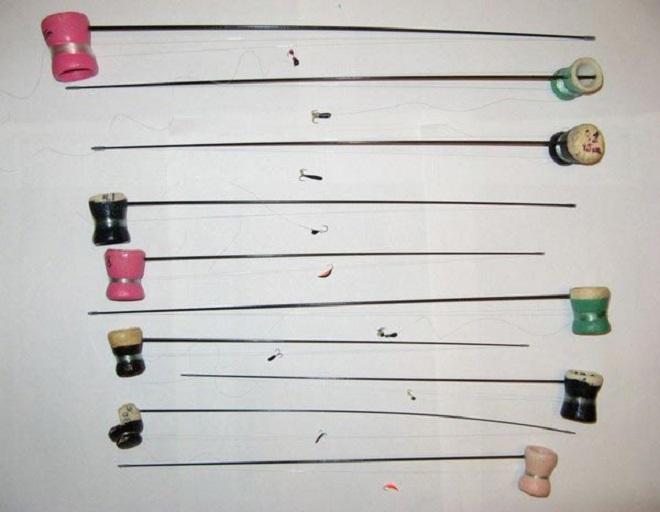
Self-production
Whip
The nodless rewinder is, first and foremost, a whip. The whip is selected according to the weight of the jig, depending on the desired game. The best solution is a carbon tip from a summer fishing rod. The thickness (power) of the whip is selected experimentally. There are a lot of options in stores; brute force and logic will help. For high-frequency play, you need a shorter whip - with a long six, such vibrations cannot be achieved. For active perch, a short whip is what you need. In the dead of winter, and especially for bream, it is better to make a long whip, 30-50 cm. With such a lever, even the slightest attempt of the fish to take the jig will be felt in the hand. The game for bream is slower than the reelless game for perch. With a long six it is easier to make the desired soft vibrations. The length of the whipless whip is also selected individually based on the angler’s habits.
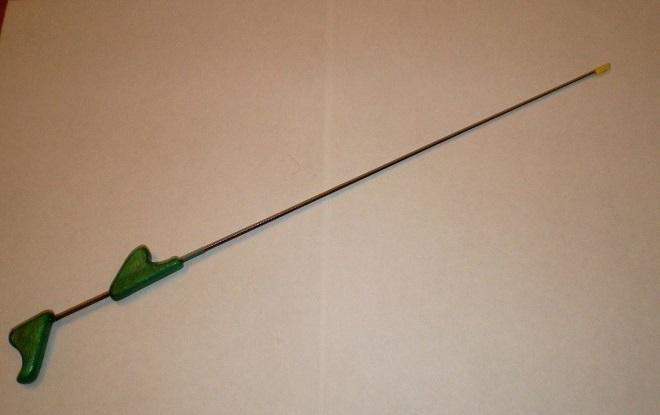
With the reelers
The soft or hard six of the rod for a nodless reelless fishing rod will become clear during experiments with the jig for which the whip is prepared. To do this, you need to attach a piece of 0.1 mm fishing line to it using a cambric, tie a reelless jig and try playing in a bucket of water. The sound of the jig as it oscillates should be felt in your hand. If it’s too weak, you need a softer whip. Solid sixes (not tubular) can be sanded to make them softer. A thin feeder whip for a nodless, reelless fishing rod is also suitable for the heaviest devils and jigs.
When the six is correctly selected, we can assume that the homemade nockless winter fishing rod is 90% ready. All that remains is to come up with a fishing line storage system. It is better to immediately prepare all the sixes for different weights, and the device for the fishing line (reel) can be made the same for the entire set of fishing rods. In a hollow six, the line can be passed inside; in a solid one, it is secured with a cambric at the tip.
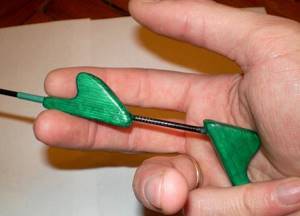
Composite reels
Reel
For fishing at great depths, it is more convenient to use a reel, however, this will make the no-kick tackle heavier. Any design of minimalist sports balalaikas or specialized balalaikas will do. For fishing at shallow depths, round reels are used based on the Shcherbakov washer principle. The workpiece is cut from solid foam or foamed PVC sheet. Then, using a file and a sharp knife, a groove is carefully removed along the radius, into which, in fact, the fishing line will be wound. This can also be done using a wine or champagne cork. At the end, the workpiece can be treated with varnish that does not corrode the material. To make it even easier, the middle is also removed, but this greatly increases the fragility of the washer (button, fungus).

Button
In addition to the radial version of non-kick washers, reels can also be cut horizontal, monolithic or composite. The blanks are cut from the same materials as the washers. The simplest life hack is the cut off part of a yogurt bottle (near the neck). Burrs are processed with a needle file. Holes of the required diameter are drilled with a drill, and a six is attached to them with superglue. It is better to glue the pole at an angle slightly downward - this will make it easier to lower the line from the reel when fishing for large fish. The winter fishing rod without a nod is ready.

From a yoghurt bottle
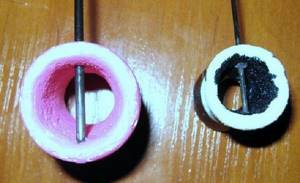
Styrofoam
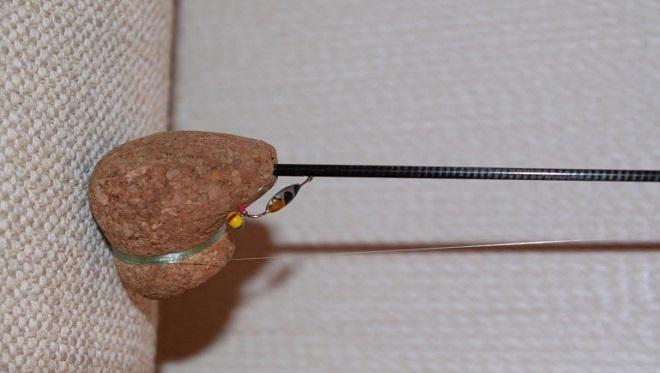
Cork
Equipment
Depending on the weight of the bait, a fishing line of 0.08-0.12 mm is installed on the nodular equipment. A reelless jig with its mass in the water should straighten the line into a straight line without waves. The best option is winter fluorocarbon with low memory. Depending on the design, the line is passed through the whip (if it is hollow), or along it using a cambric or a piece of insulation. Any design of the end connector for a nodule tackle is suitable, as long as the fishing line passes through and is not injured. A metal insert must be glued into the hollow whip at the very tip or treated with epoxy - otherwise the fishing line will quickly cut a groove in the carbon fiber. An article about tying rewindless fish to a fishing line
Subscribe to the channel:
My YouTube channel RYBAFAN on fishing:
We're OK
Under-ice trolling of perch
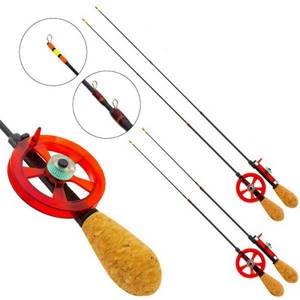
It is recommended to use carbon or carbon fiber whips. Some people use hollow ones, others prefer solid sixes. Everyone chooses the length themselves, based on personal experience, but, as a rule, 40–50 cm. Compared to others, this method is more labor-intensive and requires certain knowledge.
The fishing and guiding technique is very exciting and interesting.
We lower the spoon to the bottom and do a few small pulls. The goal is to create turbidity and sound to attract the attention of fish . Then the spoon rises about ten centimeters, and twitching and twitching of small amplitude begin. A small jerk is made, a short pause. It almost always bites on pause. And slowly, with each jerk, the bait rises upward. The depths are fished, the perch can stand in layers of water a meter, one and a half meters from the bottom.
You can make the first upward stroke more intense, it will attract fish located nearby. Having reached the top, the spoon is released smoothly down.
Important! When diving, the spoon fluctuates; the predator really loves the falling spoon. For better information content, the fishing rod is held between your fingers like a pencil.
The more active the fishing, the more impressive the catch. A little practice and everything will work out.
Installation of winter fishing rod equipment for perch
The question of what is the equipment for winter fishing rods with jigs should not cause any difficulties for the fisherman. Everything is much simpler than with summer gear.
According to some anglers, perch can be caught well on baitless gear. In winter, it happens that this fish is at the bottom or swims right under the ice. Although its activity is limited by low temperatures, anglers like to catch it with a jig.
Changing gear for different conditions of a fishing spot occurs with a change in the diameter of the fishing line, the size of the jig and the hook. The best fishing option is obtained with a certain ratio of fishing line and hook parameters.
The most commonly used line diameters are 0.05 mm; 0.06 mm; 0.07 mm.
When assembling a winter fishing rod with a jig for perch, you must follow some rules:
- the fishing rod should be comfortable and not freeze in the cold;
- fishing line with a diameter of 0.1 mm;
- a reelless jig is suitable, its weight is 0.3 g;
- If possible, make the nod from boar wool; it will be visible in the snow and has sufficient rigidity.
Correct rigging of a winter fishing rod with a jig - sequence of actions:
- The fishing line is wound on a reel with a length three times the fishing depth in this place.
- The nod is attached to the end of the fishing rod.
- The line is passed through the nod.
- The jig is tied to a fishing line, the devil, for example, is knitted vertically. Some baits are tied so that the hook is at an angle.
If we talk about choosing a jig for a winter fishing rod for catching perch, then this topic will be the most important for every angler. They can be for bloodworms and bloodworms with different beads and cambrics. Some believe that each fish should have its own type of bait; other anglers are of the opinion that the main thing for fish is the action of the jig.
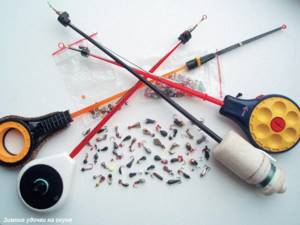
But there is also the main thing - weight. It plays a role during wiring. If you use a heavy bait, you won’t be able to lower it smoothly. And in the current, you won’t create the desired game with a light bait. Tungsten jigs for winter fishing rods are more versatile.
Considering that perch is caught all winter, the line should hold a decent trophy. Here you need to select a diameter of at least 0.1 mm. A thicker line will spoil the play of the bait, and a thin line, for example, 0.06 mm, may not withstand it. It also deteriorates on the edges of ice.
The amount of fishing line is determined by the depth of the fishing spot. Usually they wind 10-15 meters on a reel.
Winter tackle for two jigs
The advantage of this gear is simultaneous fishing at different depths. Some fishermen mount two or three jigs on a winter fishing rod to a fishing line at once. This can only work at great depths.
The top bait is attached to the fishing line itself or to a separate leash. It is pulled onto the fishing line, a knot is tied on the shank of the hook and passed through the jig again. A heavy bait is tied to the end of this line.
Another advantage of such gear is that you can immediately test two baits, for example, bloodworms and a worm. Many variations are used, this way the catchable bait is quickly identified.
You also need to be able to control such gear as a winter fishing rod with a jig. Two jigs are held at the bottom for 2-4 seconds, then they are raised quickly or slowly. The fish most often takes one of the baits, sometimes bites occur alternately: first the upper one, then the lower one.
Large fish can also be caught with this tackle. The fishing line should be 0.17-0.2 mm.
With your own hands
With the guardless method, experienced fishermen usually use homemade fishing rods.
They are easy to make and more practical than store-bought ones. There are two main types: without a coil and with a coil. Let's look at both. The handle of the reelless tackle is machined from a piece of foamed PVC or dense foam. The material for the handle should be of low thermal conductivity. Often, for better information content, you have to catch with your bare hands without gloves.
To make a whip, a hollow carbon tip from a fly rod . The length we need is sawed off, the tip is ground off, since the fishing line will pass inside the cavity. How to adjust the length to the stiffness we need is described above. The greater the depth, the higher the water resistance, the stiffer the whip should be.
When the six is adjusted correctly, we can say that the homemade no-knock is 90% ready. Both sides are processed with a file to avoid damage from sharp edges. A hole is made in the handle for tightly fastening the six and a hole for the through passage of the fishing line.
Using glue, the whip is securely fixed in the handle. It is made on the handle of the reel for winding the fishing line and is passed through the handle and elbow. To facilitate this operation, a thicker fishing line is used and with its help the necessary line is pulled through. The required length of winding of the scaffolding is carried out. A cambric is put on the tip of the whip.
If the whip is solid, which can also be used in this design, it secures the fishing line. In this version, it prevents the line from splitting the tip over time. In principle, the tackle is ready. The weight of this modification can be only five grams.
Let's move on to the coil modification. The coil used is from a regular one
“balalaikas” US-4. Its weight is 10 grams, it ensures easy rotation of the spool, does not jam, and has a low price. Holes are also made and the whip is fixed. The six is made in the same way as on the previous model. The fishing line is wound and threaded. The tackle is ready.
Design of a noddle-less fishing rod for reelless fishing
Whip
It is selected depending on the weight of the jig and the desired method of play. A whip in the form of interchangeable tips for various fishing rods can be purchased at a fishing store.
Hollow
For pulling fishing line inside the whip. You can use a carbon tip on a fly or feeder rod.
At the end of the whip, a short cambric is put on, protruding half a millimeter beyond the edge of the whip, which serves to prevent friction of the fishing line on the carbon.
As a cambric, you can use a piece of electrical wire insulation, placed on the tip of the tip in a heated state.
Pros:
- the load is distributed evenly along the axis of the whip;
- withstands heavy weight.
Minus:
Moisture getting inside the whip (when winding the fishing line onto a reel or when lowering the fishing rod onto the snow) can lead to the formation of ice. The whip will need to be warmed up.
Whole
A PVC tube is attached to the end of the whip. The fishing line is pulled along the whip and wound into a PVC tube.
Pros:
- the ability to replace the rod without dismantling the equipment;
- quick replacement of whips.
Minus:
A one-piece whip requires the presence of passage rings, which makes the structure heavier.
Replaceable whips
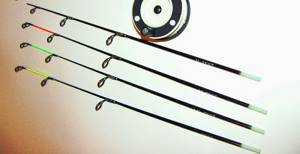
To create replaceable whips, the passage rings located on it are made with a slot for easy removal of the fishing line.
The PVC tube is removed from the top, the fishing line is removed from the guide rings through the slots. The whip is removed from the blank channel.
A PVC tube is put on the new tip, through which the fishing line has already been passed. The fishing line is threaded through the slots into the passage rings. The tip is inserted into the channel.
Minus:
The PVC tube at the end of the tip prevents the free flow of the fishing line. Passage rings slightly increase the weight of the gear.
Timber storage
- Reel for a filly-type winter fishing rod. Foamed pvc, polystyrene foam.
- Champagne cork.
- Shcherbakov's puck. Foam plastic, foamed pvc.
- The top of a plastic bottle with a wide neck.
- Reel with friction clutch.
- Axleless design.
How to choose a fishing rod for fishing with balance beams
A balancer is a bait for catching predatory fish in a vertical line, its appearance reminiscent of small fish. The fisherman’s task is to use the fishing rod to make the bait behave like a fry and provoke the trophy to bite.
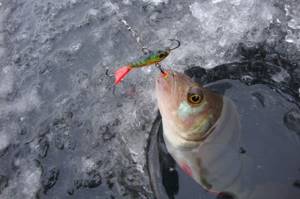
A winter fishing rod for balancers is chosen or made with your own hands so that it:
- guaranteed the reliability and strength of the tackle (after all, trophies weighing 1-3 kg, or even more, are caught on hooks or tees);
- was resistant to low temperatures, there are materials that lose their properties in the cold;
- it was comfortable and light (fishermen are on the pond all day long and do a lot of fishing during fishing);
- made it possible to quickly replace a failed section or element of equipment;
- folded quickly and did not take up little space in a fishing bag or box.
Hunting for perch or pike perch from ice requires good physical preparation from the fisherman, because in search of fish you have to drill more than one or even five holes. And waving the fishing rod up and down while retrieving is not as easy as it seems from the outside.
A light fishing rod helps the angler to conserve strength and energy and not miss even subtle movements of the nod.
The weight of the fishing rod also depends on the weight of the baits used, and taking into account the fact that when fishing you have to select a catchable balancer, there should be a considerable choice of them.
There should be a separate fishing rod for each group of artificial fish, and it is better to have in stock:
- fishing rod for balancer, for deep fishing with heavy baits;
- equipment for the middle category of balancers, both in weight and size;
- ultra-sensitive rod for the lightest lures.
It is clear that it is difficult to work with large and heavy balancers with a light fishing rod, and when using a powerful fishing rod and ultra-light baits, the sensitivity decreases.
Choosing only one gear option means losing both pleasure and catch, so fishermen carry three or five fishing rods of different designs and weights for winter fishing.
The interchangeability of equipment elements, nods or even fishing rod handles allows the fisherman to feel confident and will not have to go home due to a minor breakdown.

